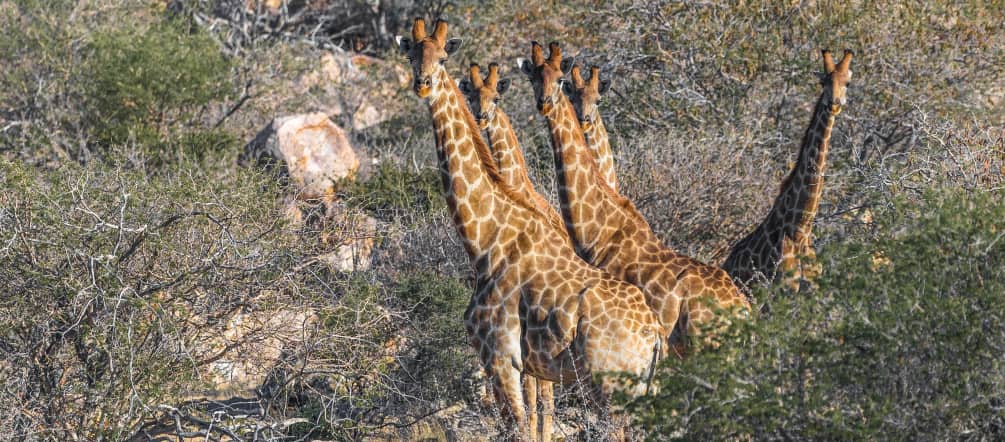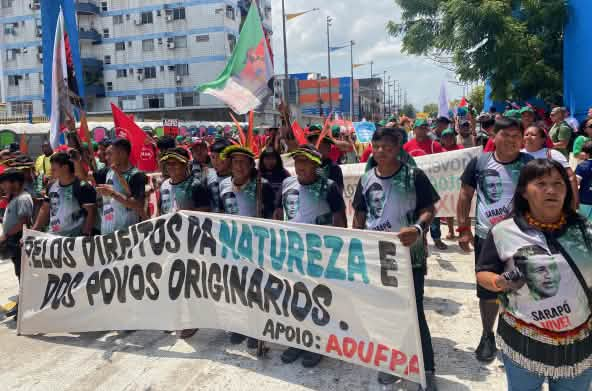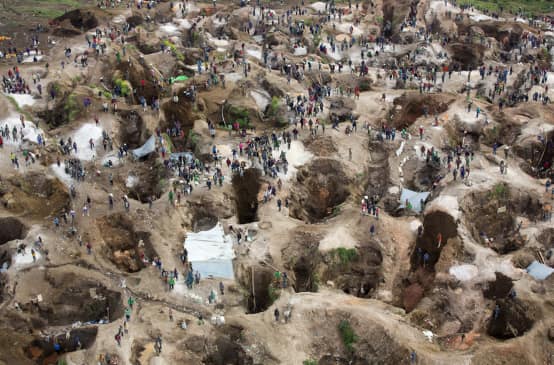
Completed campaign
Is burning trees the new coal? Say NO to fake “renewables”!
The German government is supporting the clearing of millions of bushes and trees in Namibia under the pretext of protecting the savanna against “bush encroachment”. The resulting biomass is to be processed into wood pellets and exported as a supposedly “climate-neutral” fuel for German power plants.
News and updatesTo: German Development Minister Svenja Schulze; the Hamburg Senate and environmental authority
“Stop the destruction of Namibia’s savannas – its bushes and trees must not be processed into fuel for German power plants.”About half of Namibia – an area the size of Germany and Austria put together – is overgrown with thick bush, writes the German Association for International Cooperation (GIZ), which is commissioned with implementing the project. It claims that the bush is not only displacing the grasses on which cattle herds depend, but also hindering the formation of groundwater and reducing biodiversity.
The ultimate goal of the project is to restore grazing land for cattle while using the biomass profitably. The German Ministry for Economic Cooperation and Development (BMZ) and GIZ thus plan to deploy heavy machinery to clear millions of tons of bushes and trees annually and process them in up to 105 planned biomass industrial parks.
Since more than 80 percent of the annual growth cannot be sold on the domestic market, GIZ also intends to help Namibia market the wood internationally. Processed into pellets, it would be shipped to Germany.
In this context, the city of Hamburg has entered into a biomass partnership with Namibia after GIZ approached the municipal environmental authority about burning the bush wood as a supposedly climate-friendly alternative to coal for Hamburg’s power plants.
Climate and ecosystem researchers Dr. Pierre Ibisch and Dr. Axel Schick of the Eberswalde University for Sustainable Development have sharply criticized the project and its underlying arguments in an expert opinion: “The current state of knowledge in no way supports the assumption that a sustainable export of bush biomass from Namibia is possible and reasonable – certainly not if the aim is to contribute to climate protection.”
Following protests by Rainforest Rescue and other environmental organizations, Hamburg has suspended the review process for the project and handed it over to the BMZ for further evaluation. Please sign our petition calling for this misguided project to be cancelled once and for all.
Bushes and trees – an ecological problem?
The savannas of Namibia are a habitat of great biodiversity. Many of the wild animals feed on woody plants. Antelopes, for example, eat shoots close to the ground, while elephants and giraffes graze on branches and even the treetops at lofty heights. The wildlife in the protected areas, which cover almost 20 percent of Namibia’s land area, is an important tourist attraction for the country.
The GIZ and Hamburg’s environmental authority primarily cite ecological reasons to justify the massive and wide-ranging clearing of millions of bushes and trees. By using negative terms such as ‘bush encroachment’, ‘scrub’ or ‘overgrown’, they are implying that the trees are a problem. But the bushes and trees are native species such as acacias – the main food of many wild animals such as giraffes – that are typical of savannas.
The website of the Hamburg environmental authority introduces the biomass partnership as follows: “In Namibia, bush encroachment of savannas has become a major ecological problem. Large parts of the grass savanna are encroached by primarily endemic bush species, such as black thorn, with serious consequences for animals, plants and pasture farming.”
In the background article “Bush encroachment in Namibia – an ecological problem”, the environmental authority goes as far as to claim: “Bush encroachment threatens natural habitats for animals and plants of the savanna ecosystem. Local bushes, such as black thorn (Senegalia mellifera), are spreading massively at the expense of grass vegetation in the savanna. In Namibia today, about 450,000 km2 of actually productive farmland are affected. Every year, this area increases by about 3% at the expense of savanna landscapes or rangeland , i.e. approx. 1.3 million ha/a! (In comparison: an area that is slightly smaller than Schleswig-Holstein).”
But whether this is actually an “ecological problem” is not at all certain from a scientific point of view. Climate and ecosystem researchers Dr. Pierre Ibisch and Dr. Axel Schick of the Eberswalde University for Sustainable Development sharply criticize the project and underlying arguments in an independent expert opinion:
“Vegetation changes are observed in various arid regions around the world. . . . However, the proliferation of woody plants is a complex and multidimensional phenomenon that requires a correspondingly more holistic understanding.” Neither the stated growth rates nor the stated areas of Namibian woody plants are consistent with current scientific knowledge. The project is therefore based on incorrect assumptions, prompting the researchers to strongly discourage the idea of importing bush wood from Namibia.
The researchers also point out that the term “bush encroachment” is negatively charged. It is found in studies that focus on rangeland and emphasize the negative impacts on forage production. From a neutral ecological perspective, they consider the term biased. The researchers would instead refer to the “woody plant proliferation” or “vegetation change”.
Furthermore, the claim that bushes and trees negatively impact the formation of groundwater is not scientifically documented. This finding apparently originated in a single, geographically limited research project that is not transferable to large areas of Namibia.
Burning trees on a massive scale is anything but environmentally friendly or good for the climate, as 800 scientists and 120 environmental organizations, including Rainforest Rescue, have written to the EU.
Questionable figures
The figures cited by project proponents regarding areas affected by “bush encroachment” in Namibia and the annual growth rates of shrubs and trees are also highly questionable. Comprehensive surveys of the vegetation were not produced, and the stated figure of 450,000 km² of land allegedly affected by bush encroachment has apparently been made up out of thin air. The annual growth area given as three percent was taken from a diploma thesis and is only an estimate that does not meet scientific criteria.
The planned methods for cutting down the bushes and trees and removing them are anything but ecologically sound. As can be seen in numerous studies, articles, project presentations and videos, heavy machinery such as tracked vehicles and bulldozers would be used to cut down, transport and process the vegetation.
Driving over millions of hectares of land with machines weighing many tons would undoubtedly have serious effects on the soil and other vegetation that thrives there. Up to 105 biomass industrial parks are to be built and equipped with machines and storage facilities.
Another problem is that after cutting, the bushes and trees would sprout quickly from the stumps and roots, resulting in dense growth in a short time. To prevent this, stumps and roots are torn out of the earth with bulldozers and the areas are leveled, as the GIZ documents in a study by the Southern African Institute for Environmental Assessment (SAIEA) “Strategic Environmental Assessment of Large-Scale Bush Thinning and Value-Addition Activities in Namibia” it commissioned in 2015. Alternatively, spraying with herbicides kills the vegetation entirely.
The role of the cattle industry
In large parts of Namibia’s savannas, wildlife has been shot, driven away or locked out by grazing fences. The cattle industry in particular has converted large parts of the savanna into grazing areas to produce beef for export.
According to the Namibia Statistics Agency, nearly 28 million hectares of land – 70 percent of Namibia’s agricultural land – is owned by “previously advantaged Namibians”: farm owners with European roots whose ancestors appropriated the land during the colonial period.
Between 1884 and 1915, when Namibia was a German colony, the German occupiers expelled the Herero and Nama people from their land and eliminated them in a genocide. Currently, the German government is negotiating with Namibia for public recognition of the genocide by Germany and the payment of compensation. The Herero and Nama rejected the negotiations because they were excluded from them. Negotiations without the involvement of the victims’ descendants are a farce.
Nowadays about 2,250 commercial cattle breeders in the savanna areas practice extensive cattle breeding for export on huge farms averaging many thousands of hectares each. Cattle feed on pasture grasses and and wild herbs, but not woody plants. The spread of woody plants reduces the capacity of cattle pastures and thus the number of cattle on the land. If the bushes and trees are removed, the large landowners can increase their cattle herds and do better business.
Natural savanna fires triggered by lightning strikes once regulated the spread of bushes and trees. But on rangelands, fires are usually suppressed by landowners. Changes in precipitation due to climate change and the higher concentration of CO2 in the atmosphere also seem to favor the growth of woody plants.
The interests behind biomass projects in Namibia
The Hamburg environmental authority writes: “The Association for International Cooperation (GIZ), which has been involved in Namibia for decades, and the Institute for Applied Material Flow Management (IfaS) at the Trier University of Applied Sciences first approached the environmental authority in 2019 with the idea of burning bushwood from Namibia in Hamburg power plants.” In May 2020, the Hamburg environmental authority signed a Memorandum of Understanding with IfaS for biomass partnerships with Namibia.
In Namibia, GIZ is the main driver behind the biomass projects. With funding of more than 24 million euros from the German Federal Ministry for Economic Cooperation and Development (BMZ), the German government-owned association has been promoting the Bush Control and Biomass Utilization (BCBU) project in Namibia since October 2013. It defines the project objective as “a biomass sector contributing to economic development and range land restoration”.
Opportunities for German industry and investors
The business opportunities related to biomass – the required machines, systems, infrastructure and technical expertise – promise to be a big hit, both in Namibia and Germany. Thus the Bundesverband Bioenergie e.V. (German Bioenergy Association) is looking for German mechanical engineering and plant construction companies as well as investors to construct up to 105 biomass industrial parks currently planned in Namibia on behalf of GIZ, and writes: “We will work with the German Association for International Cooperation (GIZ) GmbH to support local initiatives to improve the economic prospects of farmers and landowners with new partners from Europe.”
UNIQUE land use and forestry GmbH, a company in Freiburg im Breigau, Germany, is also playing a key role in the biomass project in Namibia. The company, which is involved in other development projects financed by the BMZ, calculated the carbon footprint of the biomass partnership project. Biofuelwatch, a British NGO, took a closer look at the study by UNIQUE, which claimed that the project would benefit Namibia’s greenhouse gas balance. In the analysis, Biofuelwatch notes that UNIQUE misrepresents many of the scientific studies cited and thus inevitably arrives at misleading conclusions.
The World Rainforest Movement (WRM) notes that UNIQUE has a stake in the Luxembourg-based Arbaro investment fund, which plans to establish 75,000 hectares of industrial timber plantations in Sierra Leone, Ghana, Uganda, Ethiopia, Peru, Ecuador and Paraguay. In Paraguay, Arbaro controls Forestal Apepú SA, a timber plantation company.
In UNIQUE’s case, the potential for conflicts of interest is obvious because of the company’s own activities in the wood and biomass business: UNIQUE is an investor in PAYCO, a company running an industrial-scale eucalyptus plantation project in Paraguay. WRM writes that the land seizures for the plantations is leading to conflicts with the ancestral residents of the land and to water pollution through the use of pesticides. UNIQUE argues against restoring land degraded by the plantations and practicing “sustainable” forestry there instead.
Around the world, tropical and subtropical drylands are being destroyed on a vast scale. At about the same southern latitude, across the Atlantic in Paraguay, companies and large landowners are bulldozing many millions of hectares of vegetation in the Chaco for the production of charcoal and to create space for cattle for the export of meat and leather, and are driving out the indigenous people who live there.
Sources and further information
- Independent expert opinion by climate and ecosystem researchers Dr. Pierre Ibisch and Dr. Axel Schick of the Eberswalde University for Sustainable Development, commissioned by Deutsche Umwelthilfe in April 2021: Namibian ‘Bush encroachment’ in context: an ecological perspective on current and future dryland greening, its causes and consequences
- Open letter from environmental organizations to German Development Minister Dr. Gerd Müller dated Feb 18, 2021 on the GIZ Bush Control and Biomass Utilization (BCBU) project
- Southern African Institute for Environmental Assessment (SAIEA), 2015, on behalf of GIZ: Support to De-bushing Project: Strategic Environmental Assessment of Large-Scale Bush. Thinning and Value-Addition Activities in Namibia: http://the-eis.com/elibrary/sites/default/files/downloads/literature/SAIEA%20-%20Bush%20Thinning%20Stragetic%20Environmental%20Assessment%202016.pdf
- Authority for the Environment, Climate, Energy and Agriculture of the City of Hamburg, undated: Projekt: Biomass Partnership Hamburg-Namibia: https://www.hamburg.de/energiewende/english/
- Authority for the Environment, Climate, Energy and Agriculture of the City of Hamburg, undated: Hintergrund: Verbuschung in Namibia – ein ökologisches Problem: https://www.hamburg.de/energiewende/namibia-biomass-partnership/14503672/verbuschung/
- Authority for the Environment, Climate, Energy and Agriculture of the City of Hamburg, May 18, 2021: Namibisches Biomasse-Projekt: Umweltbehörde setzt Prüfprozess aus: https://www.hamburg.de/bukea/15068854/2021-05-18-bukea-namibia-biomasse-projekt/
- Olbrich et.al., March 2016: Characterizing commercial cattle farms in Namibia: Risk, management, and sustainability: https://www.researchgate.net/profile/Stefan_Baumgaertner3/publication/309335857_Characterizing_commercial_cattle_farms_in_Namibia_Risk_management_and_sustainability/links/580b420e08aeef1bfee7f4c0/Characterizing-commercial-cattle-farms-in-Namibia-Risk-management-and-sustainability.pdf
- Deutsche Gesellschaft für Internationale Zusammenarbeit (German Association for International Cooperation, GIZ) Bush Control and Biomass Utilization (BCBU) in Namibia: https://www.giz.de/projektdaten/projects.action?pn=201720648&request_locale=en_GB
- Namibia Statistics Agency, Namibia Land Statistics. Booklet. September 2018: https://d3rp5jatom3eyn.cloudfront.net/cms/assets/documents/Namibia_Land_Statistics_2018.pdf
To: German Development Minister Svenja Schulze; the Hamburg Senate and environmental authority
Dear Svenja Schulze,
Ladies and Gentlemen,
We welcome the fact that you want to promote climate-friendly sources of energy.
However, we strongly oppose burning wood pellets made from bushes and trees in power plants.
We therefore firmly reject the BMZ project “Bush Control and Biomass Utilization (BCBU)” in Namibia.
Cutting down bushes and trees in large parts of Namibia’s savannas, processing them into wood pellets for export in biomass industrial parks and burning them in power plants in Germany is not an environmentally friendly way of generating power.
The African savannas are essential for the preservation of biodiversity and as significant natural carbon reservoirs for climate protection – they must not be used as sources of fuel.
We call on you to cancel the plans to cut down bushes and trees of the savanna on a grand scale and exporting the biomass as fuel for power plants!
Yours faithfully,
Success! Hamburger Energiewerke (HEnW) and the relevant politicians in Hamburg have abandoned their plans to convert the large Tiefstack combined heat and power plant in the harbour to wood and pellets from Namibia, the USA or the Baltic States.

